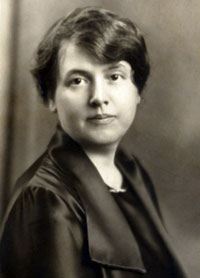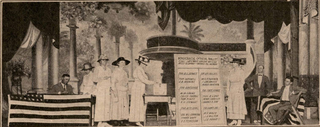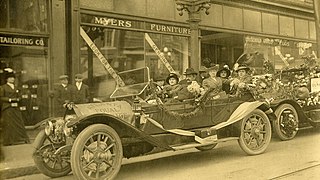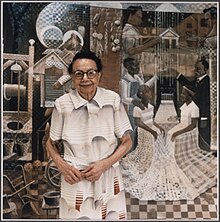
Jessie Daniel Ames was a suffragist and civil rights leader from Texas who helped create the anti-lynching movement in the American South. She was one of the first Southern white women to speak out and work publicly against lynching of African Americans, murders which white men claimed to commit in an effort to protect women's "virtue." Despite risks to her personal safety, Ames stood up to these men and led organized efforts by white women to protest lynchings. She gained 40,000 signatures of Southern white women to oppose lynching, helping change attitudes and bring about a decline in these murders in the 1930s and 1940s.

Minnie Fisher Cunningham was an American suffrage politician, who was the first executive secretary of the League of Women Voters, and worked for the passage of the Nineteenth Amendment to the United States Constitution giving women the vote. A political worker with liberal views, she became one of the founding members of the Woman's National Democratic Club. In her position overseeing the club's finances, she assisted in the organization's purchase of its Washington, D.C. headquarters, which is still in use.
This timeline highlights milestones in women's suffrage in the United States, particularly the right of women to vote in elections at federal and state levels.

Women's suffrage was established in the United States on a full or partial basis by various towns, counties, states, and territories during the latter decades of the 19th century and early part of the 20th century. As women received the right to vote in some places, they began running for public office and gaining positions as school board members, county clerks, state legislators, judges, and, in the case of Jeannette Rankin, as a member of Congress.

The Dallas Equal Suffrage Association (DESA) was an organization formed in Dallas, Texas in 1913 to support the cause of women's suffrage in Texas. DESA was different from many other suffrage organizations in the United States in that it adopted a campaign which matched the social expectations of Dallas at the time. Members of DESA were very aware of the risk of having women's suffrage "dismissed as 'unladylike' and generally disreputable." DESA "took care to project an appropriate public image." Many members used their status as mothers in order to tie together the ideas of motherhood and suffrage in the minds of voters. The second president of DESA, Erwin Armstrong, also affirmed that women were not trying to be unfeminine, stating at an address at a 1914 Suffrage convention that "women are in no way trying to usurp the powers of men, or by any means striving to wrench from man the divine right to rule." The organization also helped smaller, nearby towns to create their own suffrage campaigns. DESA was primarily committed to securing the vote for white women, deliberately ignoring African American women in the process. Their defense of ignoring black voters was justified by having a policy of working towards "only one social reform at a time."
The Texas Equal Rights Association (TERA) was the first woman's suffrage association to be formed state-wide in Texas. The organization was founded in 1893 and was an affiliate of the National American Woman Suffrage Association. The TERA was meant to "advance the industrial, educational, and equal rights of women, and to secure suffrage to them by appropriate State and national legislation." It was also an answer to Texas Governor James Stephen Hogg, who had stated publicly in a trip to the north that women's suffrage "had not reached Texas". The organization was firmly "non-sectarian", stating that "it has no war to wage on religion, church or kindred societies."

The Texas Equal Suffrage Association (TESA) was an organization founded in 1903 to support white women's suffrage in Texas. It was originally formed under the name of the Texas Woman Suffrage Association (TWSA) and later renamed in 1916. TESA did allow men to join. TESA did not allow black women as members, because at the time to do so would have been "political suicide." The El Paso Colored Woman's Club applied for TESA membership in 1918, but the issue was deflected and ended up going nowhere. TESA focused most of their efforts on securing the passage of the federal amendment for women's right to vote. The organization also became the state chapter of the National American Woman Suffrage Association (NAWSA). After women earned the right to vote, TESA reformed as the Texas League of Women Voters.

Jane Yelvington McCallum was an American politician and author, a women's suffrage and Prohibition activist, and the longest-serving Secretary of State of Texas. She attended schools in Wilson County, Texas, for the most part, and studied at the University of Texas at Austin for several years. As a suffragist, she published many columns in local newspapers in support of that cause and others. She was a member of numerous organizations. In 1927, she campaigned for Dan Moody and would be appointed as the Secretary of State after his successful election as governor. After leaving the position in 1933, she remained active in writing, activism, and political and civic affairs until she died in 1957.
Mariana Thompson Folsom was an American suffragist and a Universalist minister.

Maude E. Craig Sampson Williams was an American suffragist, teacher, civil rights leader, and community activist in El Paso, Texas. In June 1918, she formed the El Paso Negro Woman's Civic and Equal Franchise League and requested membership in the National American Woman Suffrage Association (NAWSA) through the Texas Equal Suffrage Association (TESA), but was denied. Williams organized African-American women to register and vote in the Texas Democratic Party primary in July 1918. She was one of the founders and a charter member of the El Paso chapter of the NAACP, which was the first chapter in the state of Texas. Williams served as the vice president of the El Paso chapter from 1917 to 1924 and remained active in the NAACP until her death. Williams played a significant role in the desegregation of Texas Western College in 1955, which was the first undergraduate college in Texas to be desegregated by a court order other than that of the Supreme Court of the United States. Midwestern University (now known as Midwestern State University was previously ordered to desegregate in 1954 by the SCOTUS immediately following the Brown v. Board of Education ruling.

Women's suffrage efforts in Texas began in 1868 at the first Texas Constitutional Convention. In both Constitutional Conventions and subsequent legislative sessions, efforts to provide women the right to vote were introduced, only to be defeated. Early Texas suffragists such as Martha Goodwin Tunstall and Mariana Thompson Folsom worked with national suffrage groups in the 1870s and 1880s. It wasn't until 1893 and the creation of the Texas Equal Rights Association (TERA) by Rebecca Henry Hayes of Galveston that Texas had a statewide women's suffrage organization. Members of TERA lobbied politicians and political party conventions on women's suffrage. Due to an eventual lack of interest and funding, TERA was inactive by 1898. In 1903, women's suffrage organizing was revived by Annette Finnigan and her sisters. These women created the Texas Equal Suffrage Association (TESA) in Houston in 1903. TESA sponsored women's suffrage speakers and testified on women's suffrage in front of the Texas Legislature. In 1908 and 1912, speaking tours by Anna Howard Shaw helped further renew interest in women's suffrage in Texas. TESA grew in size and suffragists organized more public events, including Suffrage Day at the Texas State Fair. By 1915, more and more women in Texas were supporting women's suffrage. The Texas Federation of Women's Clubs officially supported women's suffrage in 1915. Also that year, anti-suffrage opponents started to speak out against women's suffrage and in 1916, organized the Texas Association Opposed to Woman Suffrage (TAOWS). TESA, under the political leadership of Minnie Fisher Cunningham and with the support of Governor William P. Hobby, suffragists began to make further gains in achieving their goals. In 1918, women achieved the right to vote in Texas primary elections. During the registration drive, 386,000 Texas women signed up during a 17-day period. An attempt to modify the Texas Constitution by voter referendum failed in May 1919, but in June 1919, the United States Congress passed the Nineteenth Amendment. Texas became the ninth state and the first Southern state to ratify the Nineteenth Amendment on June 28, 1919. This allowed white women to vote, but African American women still had trouble voting, with many turned away, depending on their communities. In 1923, Texas created white primaries, excluding all Black people from voting in the primary elections. The white primaries were overturned in 1944 and in 1964, Texas's poll tax was abolished. In 1965, the Voting Rights Act was passed, promising that all people in Texas had the right to vote, regardless of race or gender.

Belle Christie Ferguson Critchett was an American social activist and suffragist. Critchett was active in Texas, especially in El Paso and was part of the Texas Equal Suffrage Association (TESA). She worked with suffragist Maude E. Craig Sampson to increase opportunities for Black women voters. Later, she became president of the El Paso chapter of the League of Women Voters.

The first women's suffrage group in Georgia, the Georgia Woman Suffrage Association (GWSA), was formed in 1892 by Helen Augusta Howard. Over time, the group, which focused on "taxation without representation" grew and earned the support of both men and women. Howard convinced the National American Women's Suffrage Association (NAWSA) to hold their first convention outside of Washington, D.C., in 1895. The convention, held in Atlanta, was the first large women's rights gathering in the Southern United States. GWSA continued to hold conventions and raise awareness over the next years. Suffragists in Georgia agitated for suffrage amendments, for political parties to support white women's suffrage and for municipal suffrage. In the 1910s, more organizations were formed in Georgia and the number of suffragists grew. In addition, the Georgia Association Opposed to Woman Suffrage also formed an organized anti-suffrage campaign. Suffragists participated in parades, supported bills in the legislature and helped in the war effort during World War I. In 1917 and 1919, women earned the right to vote in primary elections in Waycross, Georgia and in Atlanta respectively. In 1919, after the Nineteenth Amendment went out to the states for ratification, Georgia became the first state to reject the amendment. When the Nineteenth Amendment became the law of the land, women still had to wait to vote because of rules regarding voter registration. White Georgia women would vote statewide in 1922. Native American women and African-American women had to wait longer to vote. Black women were actively excluded from the women's suffrage movement in the state and had their own organizations. Despite their work to vote, Black women faced discrimination at the polls in many different forms. Georgia finally ratified the Nineteenth Amendment on February 20, 1970.

This is a timeline of women's suffrage in Georgia. Women's suffrage in Georgia started in earnest with the formation of the Georgia Woman Suffrage Association (GWSA) in 1892. GWSA helped bring the first large women's rights convention to the South in 1895 when the National American Woman's Suffrage Association (NAWSA) held their convention in Atlanta. GWSA was the main source of activism behind women's suffrage until 1913. In that year, several other groups formed including the Georgia Young People's Suffrage Association (GYPSA) and the Georgia Men's League for Woman Suffrage. In 1914, the Georgia Association Opposed to Women's Suffrage (GAOWS) was formed by anti-suffragists. Despite the hard work by suffragists in Georgia, the state continued to reject most efforts to pass equal suffrage. In 1917, Waycross, Georgia allowed women to vote in primary elections and in 1919 Atlanta granted the same. Georgia was the first state to reject the Nineteenth Amendment. Women in Georgia still had to wait to vote statewide after the Nineteenth Amendment was ratified on August 26, 1920. Native American and African American women had to wait even longer to vote. Georgia ratified the Nineteenth Amendment in 1970.

The first women's suffrage effort in Florida was led by Ella C. Chamberlain in the early 1890s. Chamberlain began writing a women's suffrage news column, started a mixed-gender women's suffrage group and organized conventions in Florida.
This is a timeline of women's suffrage in Florida. Ella C. Chamberlain began women's suffrage efforts in Florida starting in 1892. However, after Chamberlain leaves the state in 1897, suffrage work largely ceases until the next century. More women's suffrage groups are organized, with the first in the twentieth century being the Equal Franchise League in Jacksonville, Florida in 1912. Additional groups are created around Florida, including a Men's Equal Suffrage League of Florida. Suffragists lobby the Florida Legislature for equal suffrage, hold conventions, and educate voters. Several cities in Florida pass laws allowing women to vote in municipal elections, with Fellsmere being the first in 1915. Zena Dreier becomes the first woman to legally cast a vote in the South on June 19, 1915. On May 26, 1919, women in Orlando vote for the first time. After the passage of the Nineteenth Amendment, Helen Hunt West becomes the first woman in Florida to register to vote under equal franchise rules on September 7, 1920. Florida does not ratify the Nineteenth Amendment until May 13, 1969.

This is a timeline of women's suffrage in Arkansas. Early suffrage efforts date back to 1868 when Miles Ledford Langley tries to add a women's suffrage law in the state constitutional convention. The first women's suffrage organization in the state was created by Lizzie Dorman Fyler in 1881 and lasts until 1885. Another suffrage group is started in 1888 by Clara McDiarmid. Women's suffrage work continues steadily, though slowed down until the 1910s. New suffrage organizations began to form and campaigned for women's suffrage legislation. In 1917, women earned the right to vote in state primary elections. In May 1918 between 40,000 and 50,000 voted for the first time in Arkansas' primaries. On July 28, 1919 Arkansas ratified the Nineteenth Amendment. On December 3, 1919 the League of Women Voters (LWV) of Arkansas was formed.

Women's suffrage had early champions among men in Arkansas. Miles Ledford Langley of Arkadelphia, Arkansas proposed a women's suffrage clause during the 1868 Arkansas Constitutional Convention. Educator, James Mitchell wanted to see a world where his daughters had equal rights. The first woman's suffrage group in Arkansas was organized by Lizzie Dorman Fyler in 1881. A second women's suffrage organization was formed by Clara McDiarmid in 1888. McDiarmid was very influential on women's suffrage work in the last few decades of the nineteenth century. When she died in 1899, suffrage work slowed down, but did not all-together end. Both Bernie Babcock and Jean Vernor Jennings continued to work behind the scenes. In the 1910s, women's suffrage work began to increase again. socialist women, like Freda Hogan were very involved in women's suffrage causes. Other social activists, like Minnie Rutherford Fuller became involved in the Political Equality League (PEL) founded in 1911 by Jennings. Another statewide suffrage group, also known as the Arkansas Woman Suffrage Association (AWSA) was organized in 1914. AWSA decided to work towards helping women vote in the important primary elections in the state. The first woman to address the Arkansas General Assembly was suffragist Florence Brown Cotnam who spoke in favor of a women's suffrage amendment on February 5, 1915. While that amendment was not completely successful, Cotnam was able to persuade the Arkansas governor to hold a special legislative session in 1917. That year Arkansas women won the right to vote in primary elections. In May 1918, between 40,000 and 50,000 white women voted in the primaries. African American voters were restricted from voting in primaries in the state. Further efforts to amend the state constitution took place in 1918, but were also unsuccessful. When the Nineteenth Amendment passed the United States Congress, Arkansas held another special legislative session in July 1919. The amendment was ratified on July 28 and Arkansas became the twelfth state to ratify the Nineteenth Amendment.

Martha Goodwin Tunstall (1838-1911) was an abolitionist and Unionist, supporter of Radical Republicans and one of the earliest organizers of the Texas women's suffragist movement. She was politically active in the movement from the late 1860s through the 1880s. She worked with national suffrage organizations, in particular as a representative of Texas in the National Woman Suffrage Association (NWSA) led by Elizabeth Cady Stanton.



















